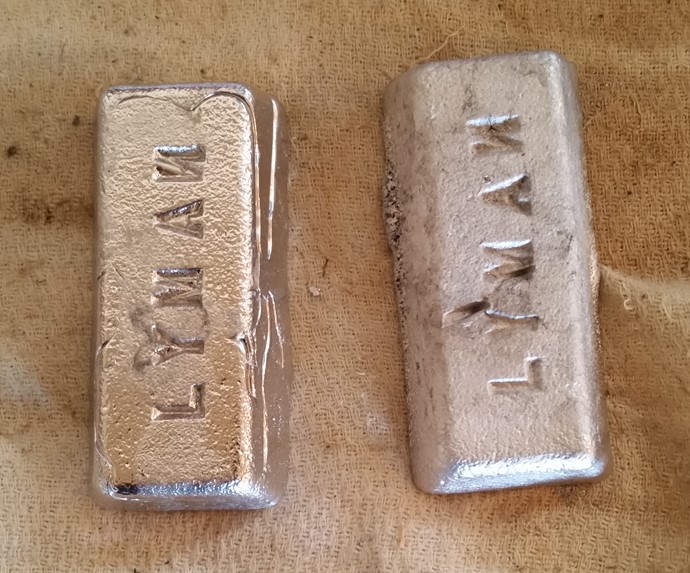I am a new member of the forum. I've been casting for about 10 years and just experienced something I've never seen before. I mixed up a batch of Lyman #2 from some linotype, pure lead, and tin. I poured it into my ingot mold. I got several good looking ingots. The last couple of ingots were different. They came out very soft, almost gooey, with a much duller sheen. The metal almost crumbles. I had almost 10 pounds of alloy! Anyone know what might have happened and whether or not it can be fixed?
Goopy Alloy
- 282 Views
- Last Post 07 November 2020
- Topic Is Solved
In 45 years of casting have to admit this is a new one on me. It's almost as if the base metals did not mix, which even with minimal stirring and fluxing seems impossible. Watching this thread as I am really curious as to what could have happened.
Attached Files
Once they cooled they seem to both be about the same hardness (totally unscientific "press on it with a screwdriver tip" method), but the later ingot still had a much duller sheen. I'll see if I can upload a picture.
Attached Files
Early ingot on the left, later ingot that came out goopy on the right. They are both cooled and both seem to be hard now, but when they were still hot the dull ingot was much softer than the shiny one. The dull ones (there were two) also seemed to stick to the cloth I dumped them out on, while the shiny ones did not.
Attached Files
Is it possible that when you started pouring ingots you turned off the heat and the cooler temperature resulted in a different appearance? If the melt was cooler, it would be very sluggish when pouring and since it was the last pour, you may have dumped the ingot as soon as it was no longer fluid but soft and crumbly.
Attached Files
I didn't turn the pot off until I had poured all the ingots.
Attached Files
...or going the other way, maybe the last of the melt got real hot and this is just a " frosted " pour.
cut the frosty ingot in half and see if the inside ( away from room oxygen ) is shiny . if so, good to go, no problem ... frosty is fine.
best i can do with no real better ideas ... heh ...
ken
Attached Files
...or going the other way, maybe the last of the melt got real hot and this is just a " frosted " pour.
cut the frosty ingot in half and see if the inside ( away from room oxygen ) is shiny . if so, good to go, no problem ... frosty is fine.
best i can do with no real better ideas ... heh ...
ken
AGREE - the one on the right looks like it was poured at a higher temperature. Would therefore be still semi-molten for a longer period of time. And surface would be different. It fits as the pot would have the ability to heat it up more since there was less alloy inthe pot. My guess.
Attached Files
Shiny ingot is too cold the dull ingot is too hot. Thats all it is.
Attached Files
The temperature of the ingot mold will also affect sheen and solidifying time.
Attached Files
This looks like the frosted bullet/shiny bullet question. The answer is no difference just crystal size.
The "gooey" pour was probably partly melted. Non-eutetic alloys like #2 have an intermediate stage between solid and melted. Here they are crumbly, metallurgists call this condition "hot short"
Attached Files
That sure sounds like what I experienced. When it was hot or was crumbly, when it cooled it hardened. Thanks for the info.
Attached Files
Preparing 130 to 140 pounds of common hard alloy at a time, these forms occur as the smelting proceeds. This is a two-man operation with many ingot molds using scrap wood and a large iron kettle.
Starting in the morning and proceeding, the initial form of the ingots are like the ones on the left. Soon the molds heat up and the ingots take on the form on the right. Assume this form is due to the latent heat in the molds as we are handling everything with long tongs.
The bullets cast from either ingot are the same for weight and hardness.
Farm boy from Illinois, living in the magical Pacific Northwest
Attached Files
Categories
- All Categories
- General Polls
- Contact Us w/ Forum Issues
- Welcome to The Cast Bullet Association Forum
- General
- Bullet Casting
-
Guns and Shooting
- AR Platform
- TC Contenders & Other Single Shot Handguns
- Shotguns
- Informal Matches & Other Shooting Events
- Gunsmithing Tips
- Gun Cleaning & Maintenance
- Optics
- Benchrest Cast Bullet Shooting
- Military Bench Rest Cast Bullet Shooting
- Silhouette Shooting
- Postal Match Cast Bullet Shooting
- Factory Guns
- Black Powder Cartridge
- Hand Guns
- Lever Guns
- Single Shot Rifles
- Bolt Action Rifles
- Military Surplus Rifles
- Plinkers Hollow
- Muzzleloaders
- Hunting
- Reloading
- Buy, Sell or Trade
- Other Information & Reference
Search
This Weeks High Earners
-
 wimilkman
28
wimilkman
28
-
 pat i.
18
pat i.
18
-
 Tom Acheson
14
Tom Acheson
14
-
 Aaron
12
Aaron
12
-
BRatigan 10
-
 MarkinEllensburg
9
MarkinEllensburg
9
-
 Ed Harris
8
Ed Harris
8
-
mashburn 6
-
porthos 5
-
MP1886 4







